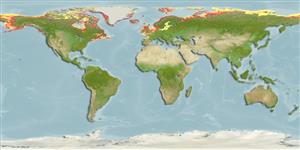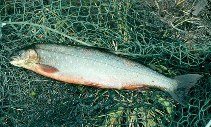Salvelinus alpinus (Linnaeus, 1758)
Arctic char
個人による観察記録の追加 Fish Watcher
| Native range | All suitable habitat | Point map | Year 2050 |

|
| This map was computer-generated and has not yet been reviewed. |
| Salvelinus alpinus AquaMaps Data sources: GBIF OBIS |
Sweden country information
Common names:
Fjällröding, Röding
Occurrence: native
Salinity: freshwater
Abundance: | Ref:
Importance: | Ref:
Aquaculture: | Ref:
Regulations: | Ref:
Uses: no uses
Comments: Occurrence: Native and regular (Ref. 30402).
National Checklist: Sweden checklist - Fish
Country Information: https://www.cia.gov/library/publications/resources/the-world-factbook/geos/sw.html
National Fisheries Authority:
Occurrences: Occurrences Point map
Main Ref: Blanc, M., J.-L. Gaudet, P. Banarescu and J.-C. Hureau, 1971
National Database: Swedish Museum of Natural History
Occurrence: native
Salinity: freshwater
Abundance: | Ref:
Importance: | Ref:
Aquaculture: | Ref:
Regulations: | Ref:
Uses: no uses
Comments: Occurrence: Native and regular (Ref. 30402).
National Checklist: Sweden checklist - Fish
Country Information: https://www.cia.gov/library/publications/resources/the-world-factbook/geos/sw.html
National Fisheries Authority:
Occurrences: Occurrences Point map
Main Ref: Blanc, M., J.-L. Gaudet, P. Banarescu and J.-C. Hureau, 1971
National Database: Swedish Museum of Natural History
Common names from other countries
分類 / Names 共通名の | 類義語 | Catalog of Fishes(部類, 種) | ITIS | CoL | WoRMS | Cloffa
> Salmoniformes (Salmons) > Salmonidae (Salmonids) > Salmoninae
Etymology: Salvelinus: Old name for char; it is the same root of german "saibling" = little salmon (Ref. 45335).
More on author: Linnaeus.
Etymology: Salvelinus: Old name for char; it is the same root of german "saibling" = little salmon (Ref. 45335).
More on author: Linnaeus.
Issue
The species Salvelinus aureolus Bean, 1887 is considered as valid in Eschmeyer (CofF ver. May 2011: Ref. 86870) following Fuller et al. (1999: Ref. 87253). Treated as synonym of Salvelinus alpinus oquassa by Qadi (1974: Ref. 87252); and probably a synonym of Salvelinus alpinus (see Nelson et al. 2004: Ref. 52299 for taxonomic issues). Please send references, or more studies are needed.
Environment: milieu / climate zone / depth range / distribution range 生態学
海; 新鮮な水; 汽水性の 底生の漂泳性; 昇流魚 (Ref. 51243); 深さの範囲 0 - 70 m (Ref. 30578), usually 0 - 1 m (Ref. 101587). Temperate; 4°C - 16°C (Ref. 2059); 82°N - 41°N, 180°W - 180°E (Ref. 117475)
分布 国々 | 国連食糧農業機関の区域 | エコシステム | 事件 | Point map | 導入 | Faunafri
Europe and North America: Circumpolar (Ref. 86798). Iceland, Scandinavia, northern Russia (absent in rivers draining to Baltic and White Seas), Jan Mayen, Spitzberg, Kolguev, Bear and New Zemblia islands, northern Siberia, Alaska, Canada and Greenland; absent in the Alps (Ref. 59043). North America: coastal areas in Atlantic, Arctic and Pacific drainages from Newfoundland and Labrador in Canada to Alaska; south along Alantic Slope to Maine, USA (Ref. 86798). Landlocked populations in Quebec, Canada and in Maine and New Hampshire in USA (Ref. 7251).
Length at first maturity / サイズ / 重さ / 年齢
Maturity: Lm 60.0 range ? - ? cm
Max length : 107 cm TL オス/雌雄の選別がない; (Ref. 40637); common length : 40.0 cm TL オス/雌雄の選別がない; (Ref. 4779); 最大公表体重: 15.0 kg (Ref. 4779); 最大記録サイズ: 40 年 (Ref. 46974)
Max length : 107 cm TL オス/雌雄の選別がない; (Ref. 40637); common length : 40.0 cm TL オス/雌雄の選別がない; (Ref. 4779); 最大公表体重: 15.0 kg (Ref. 4779); 最大記録サイズ: 40 年 (Ref. 46974)
簡単な記述 検索表 | 形態学 | 形態計測学
背面の脊椎 (合計) : 4 - 5; 背鰭 (合計) : 8 - 16; 肛門の骨: 3 - 4; 臀鰭: 7 - 15; 脊つい: 62 - 68. Distinguished by the presence of 23 to 32 gill rakers, 37 to 75 pyloric caeca and, on the sides and back, pink to red spots, the largest of which are usually larger than the pupil of the eye (Ref. 27547). Lateral line curves slightly downward from the head (Ref. 27547). Pelvic fins with axillary process; caudal emarginate (Ref. 27547). Color highly variable, depending on location, time of year and degree of sexual development. In general, back is dark, usually rather brown but sometimes with a green cast; the sides are lighter, belly pale; sides and back are liberally sprinkled with pink to red spots, the largest spots along the lateral line usually larger than the pupil of the eye; forward edges of pectoral, pelvic and anal fins, and sometimes the caudal, with a narrow white margin; fins pale in young, dorsal and caudal dark in adults (Ref. 27547). Spawning adults, especially males, are brilliant orange-red to bright red on the ventral side and on the pectoral, pelvic and anal fins. Young have about 11 dark parr marks on each side (Ref. 27547). Caudal fin with 19 rays (Ref. 2196).
Nerito-pelagic (Ref. 58426). Occurs in the sea along coasts, estuaries, rivers, and lakes with cold, clear water (Ref. 59043). Found in deep runs and pools of medium to large rivers (Ref. 5723, 86798). Anadromous forms spend a considerable time of their lives at sea; non-migratory populations remain in lakes and rivers (Ref. 4779). Anadromous populations enter rivers to breed during fall and winter (Ref. 86798). Freshwater populations feed on planktonic crustaceans, amphipods, mollusks, insects and fishes (Ref. 4479). Anadromous individuals feed little in freshwater and never feed during migrations. Spawning usually takes place on pebble to stone bottom in lakes. Riverine stocks spawn in rivers with slow current (02.-0.8 m/s), but there are some riverine anadromous stocks (in Norway) which spawn yearly in fast-flowing waters of riffles (Ref. 59043). Extremely sensitive to water pollution (cold water and oxygen oriented) (Ref. 2163). Marketed fresh, smoked, canned (Ref. 27547), and frozen. Eaten sautéed, broiled, fried, microwaved and baked (Ref. 9988). Parasitized by tapeworm (Ref. 37032).
Life cycle and mating behavior 成熟 | 繁殖 | 放精 | 卵 | 生産力 | 幼生
Males are generally territorial but when females start showing spawning behavior, males pair up with females and lose interest in their territories. Spawning takes place at almost any time of the day. A female invades a males territory and finds a suitable spot for a redd. Once a spot has been selected, she starts digging. While the female is digging, the male courts her by circling around her and then gliding along her side and quivering. When the redd is completed, the pair release egg and sperm. The pair then swim forward out of the nest, often still ejecting sex products. This may be repeated up to 5 times before the female begins to cover the eggs. The female then digs at the edge of the pit, covering the eggs and beginning the next redd (Ref. 27547). Males often mate with more than one female, taking the second mate after the first has exhausted the eggs. Sometimes, a female will mate successively with two or more males (Ref. 28968, 28969). Several days are usually required for females to deposit all their eggs (Ref. 27547).
主な参考文献
Upload your references | 参考文献 | コーディネーター | 協力者
Page, L.M. and B.M. Burr, 2011. A field guide to freshwater fishes of North America north of Mexico. Boston : Houghton Mifflin Harcourt, 663p. (Ref. 86798)
人間に対する脅威
Harmless
Human uses
水産業: 少数商業の; 水産養殖: 商業; ゲームフィッシュ: はい
FAO(Aquaculture systems: 代謝; 水産業: 代謝; publication : search) | FishSource | 私達の周りの海
より多くの情報
Population dynamics
成長のパラメーター
Max. ages / sizes
Length-weight rel.
Length-length rel.
体長組成
Mass conversion
補充
豊度
成長のパラメーター
Max. ages / sizes
Length-weight rel.
Length-length rel.
体長組成
Mass conversion
補充
豊度
Anatomy
カマ
Brain
Otolith
カマ
Brain
Otolith
Physiology
Body composition
Nutrients
酸素消費
水泳形態
泳ぐ速さ
Visual pigments
Fish sound
Diseases & Parasites
Toxicity (LC50s)
Body composition
Nutrients
酸素消費
水泳形態
泳ぐ速さ
Visual pigments
Fish sound
Diseases & Parasites
Toxicity (LC50s)
用具
E-book | 野外観察図鑑 | 検索表 | Length-frequency wizard | 生活史の基盤ツール | 目的のマップ | Classification Tree
| Catch-MSY |
特記事項
XMLをダウンロードして下さい
インターネットの情報源
Alien/Invasive Species database | Aquatic Commons | BHL | Cloffa | BOLDSystems | Websites from users | Check FishWatcher | CISTI | Catalog of Fishes(部類, 種) | DiscoverLife | DORIS | ECOTOX | Faunafri | Fishtrace | GenBank(ゲノム, ヌクレオチド) | GloBI | GOBASE | | Google Books | Google Scholar | Google | IGFA World Record | MitoFish | 国のデーターベース | Otolith Atlas of Taiwan Fishes | 公共の水族館 | PubMed | Reef Life Survey | Scirus | SeaLifeBase | 生命の木 | Wikipedia(行く, 検索する) | World Records Freshwater Fishing | 動物に関する記録
Estimates based on models
Preferred temperature (Ref. 115969): 0.1 - 9.7, mean 1.9 (based on 316 cells).
Phylogenetic diversity index (Ref. 82804): PD50 = 0.5000 [Uniqueness, from 0.5 = low to 2.0 = high].
Bayesian length-weight: a=0.00724 (0.00449 - 0.01169), b=3.03 (2.89 - 3.17), in cm Total Length, based on LWR estimates for this species & (Sub)family-body (Ref. 93245).
栄養段階 (Ref. 69278): 4.4 ±0.5 se; based on diet studies.
回復力 (Ref. 120179): 低い, 4.5年~14年の倍増期間の最小個体群 (tm=7-10; tmax=24; Fec=400).
Prior r = 0.24, 95% CL = 0.16 - 0.35, Based on 2 full stock assessments.
Fishing Vulnerability (Ref. 59153): High to very high vulnerability (70 of 100).
Climate Vulnerability (Ref. 125649): High to very high vulnerability (71 of 100).




